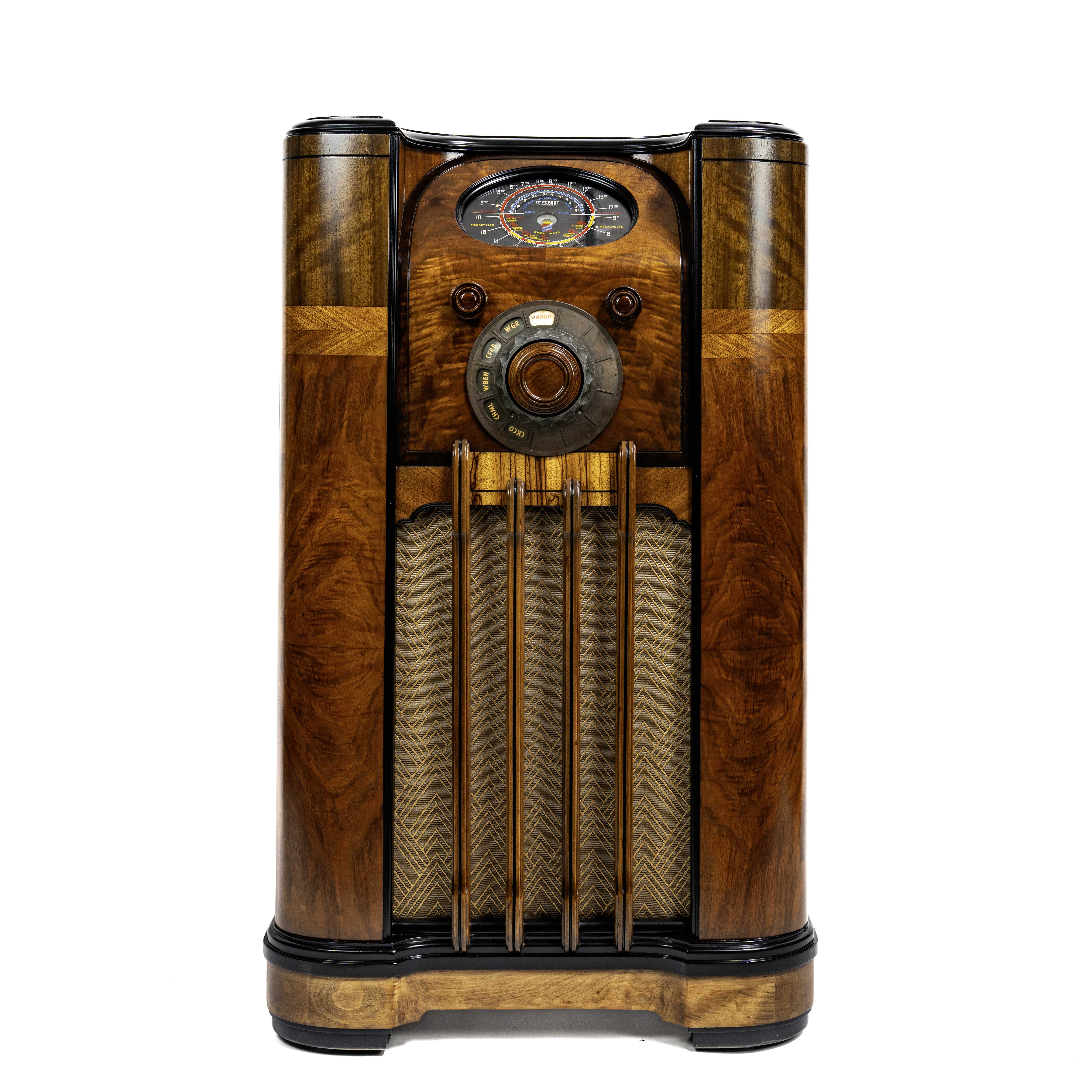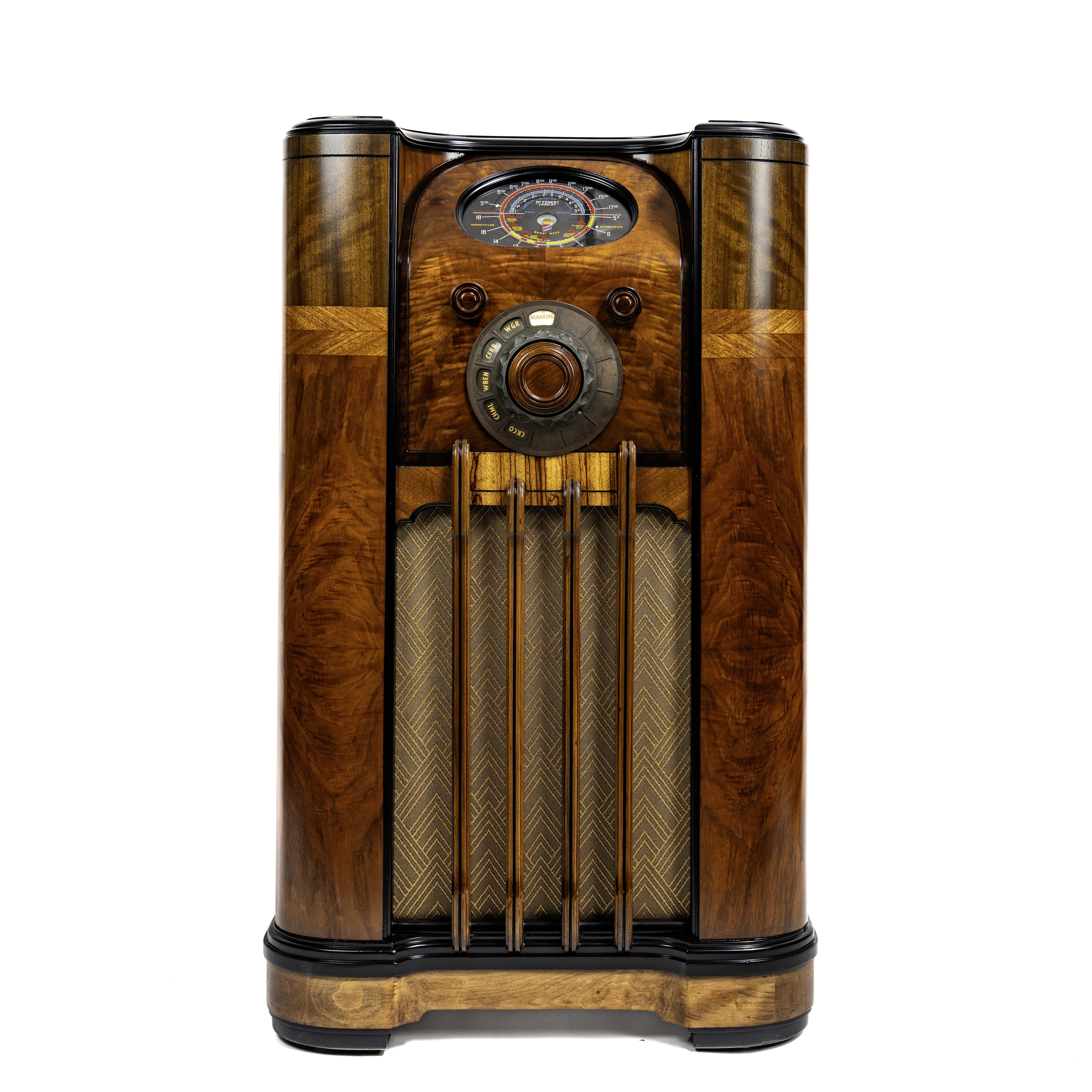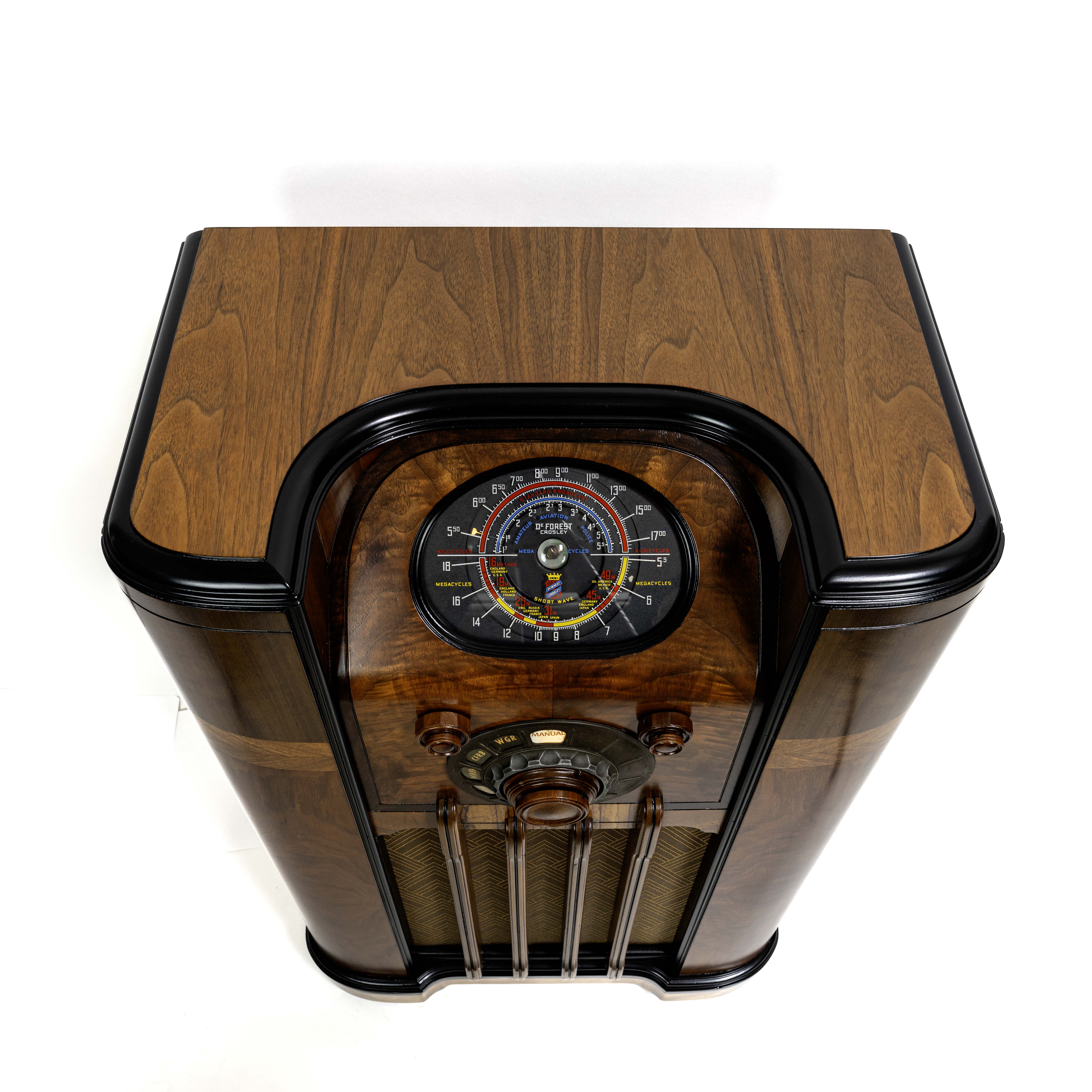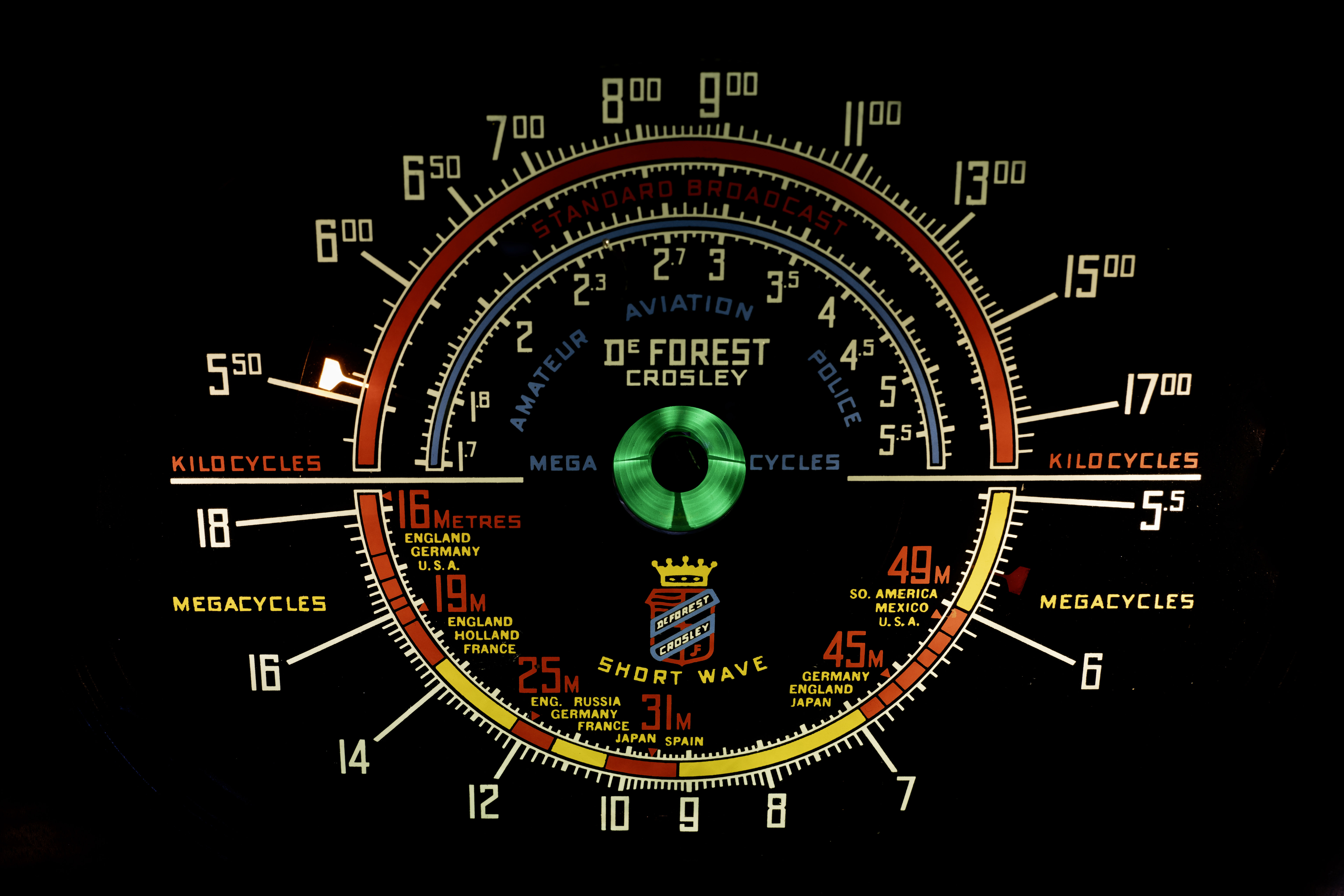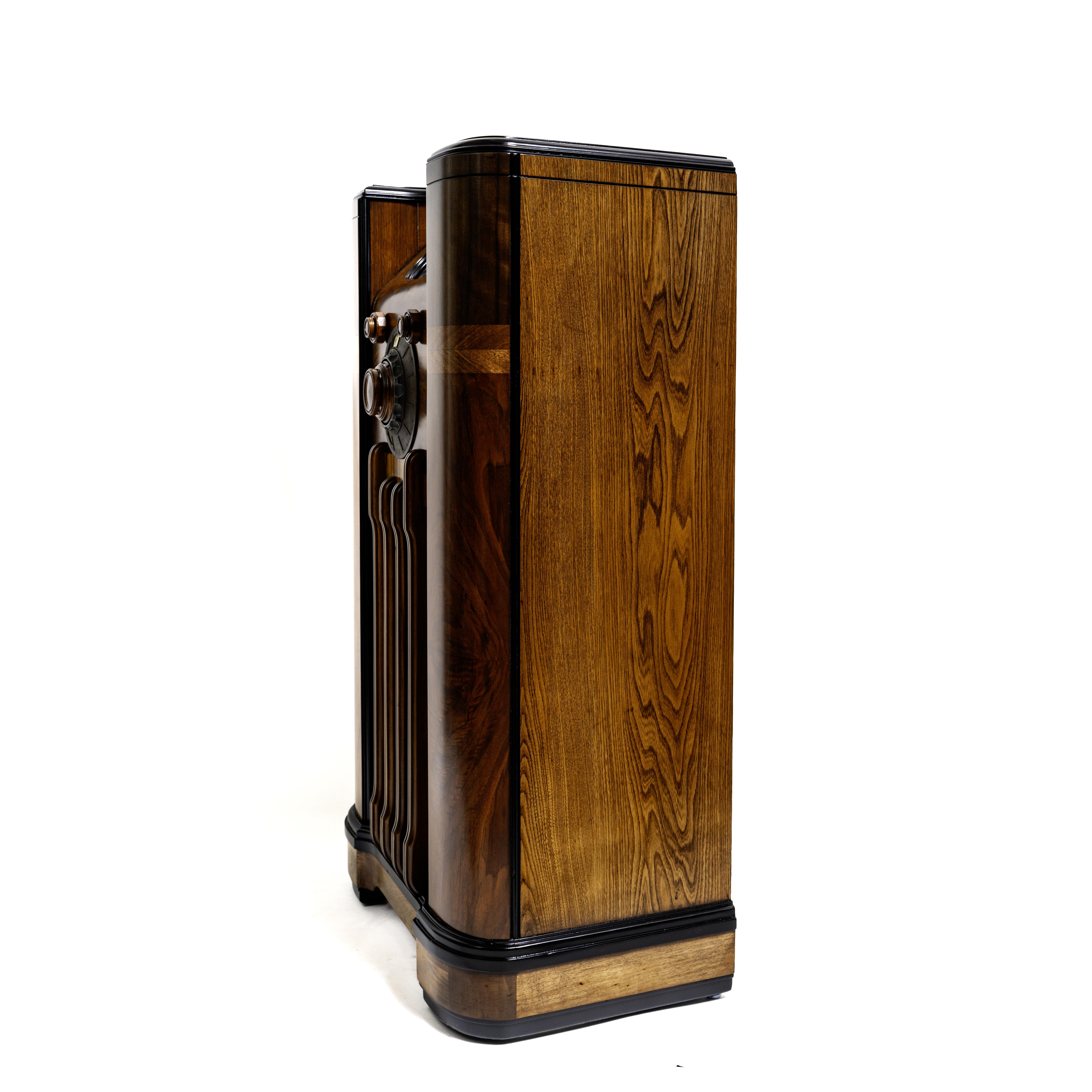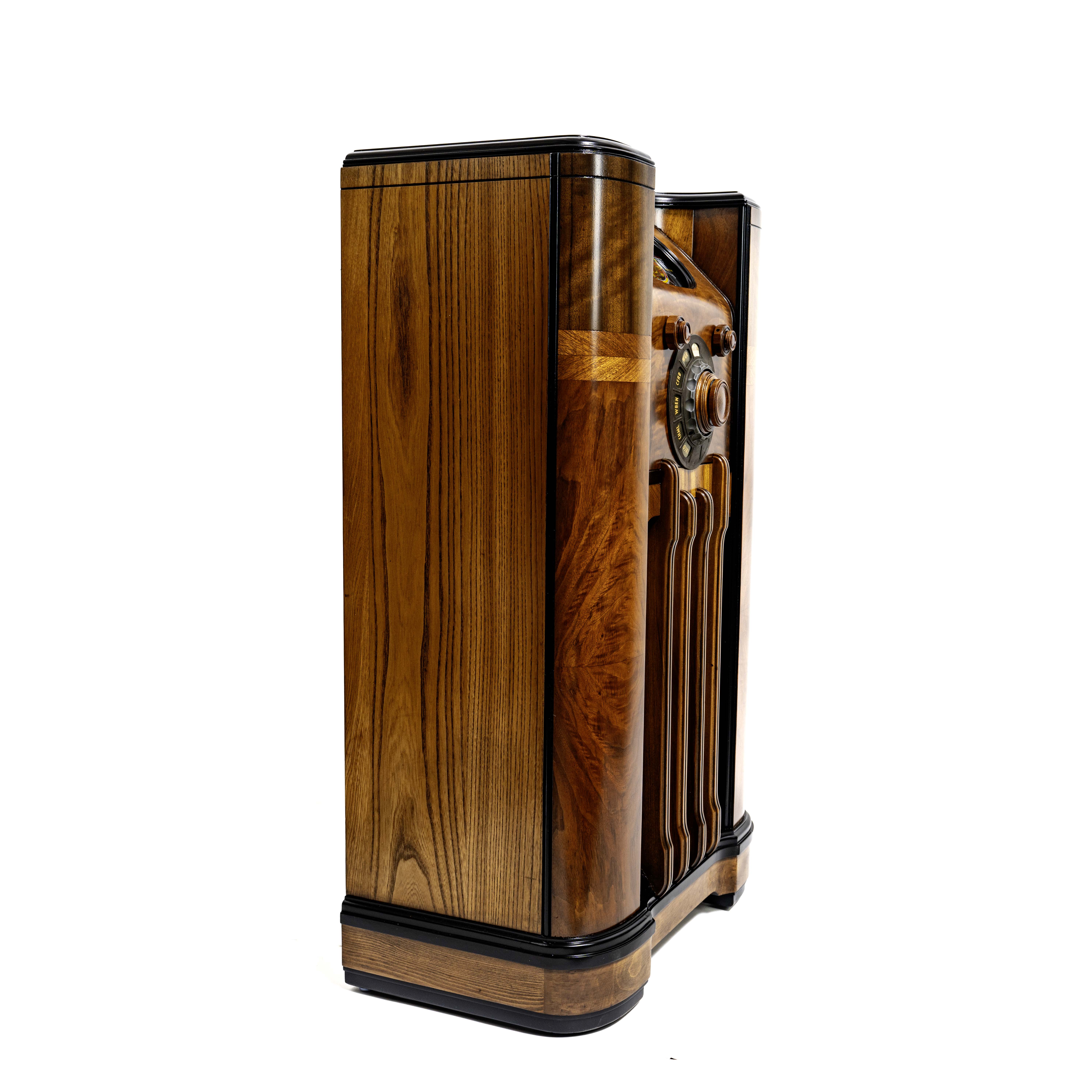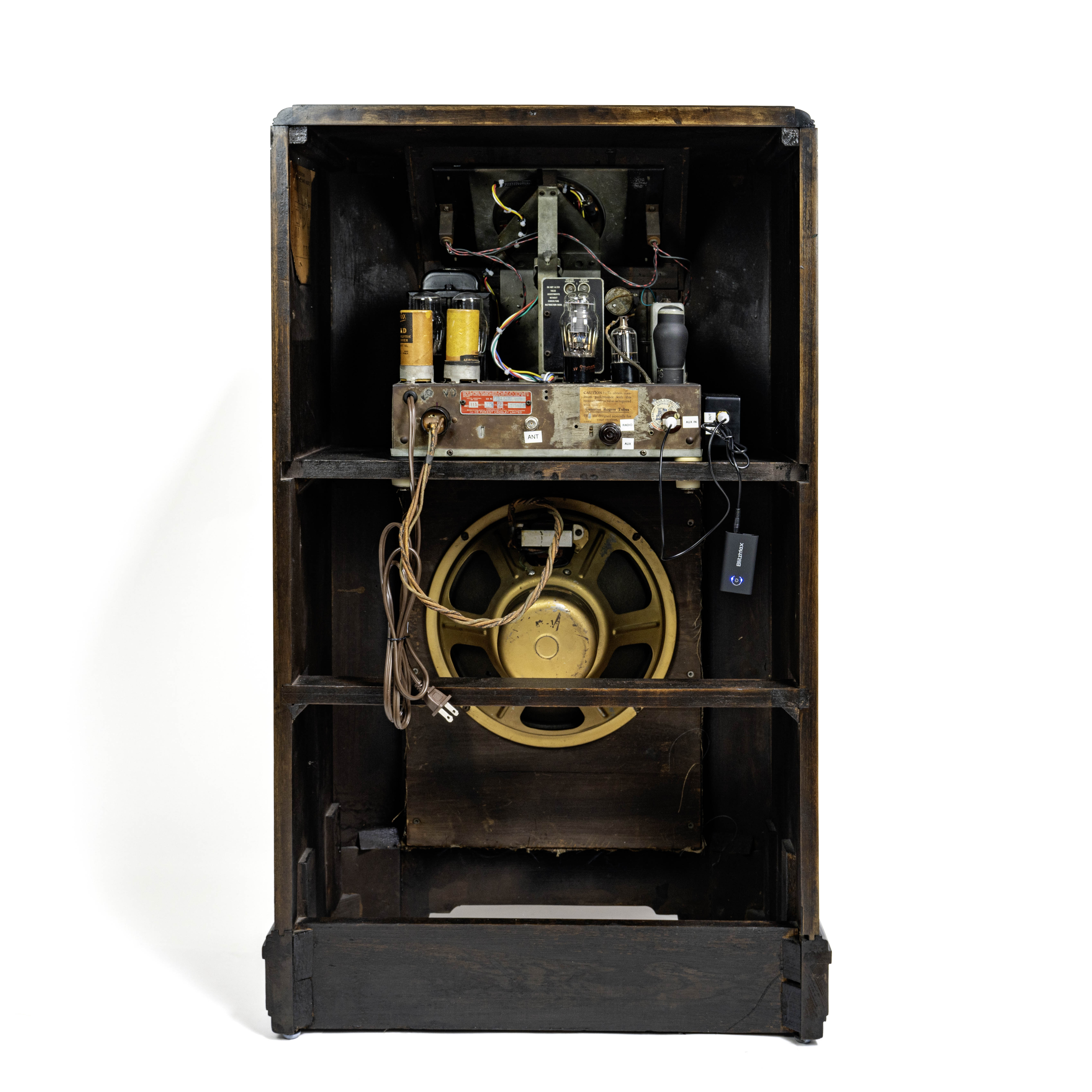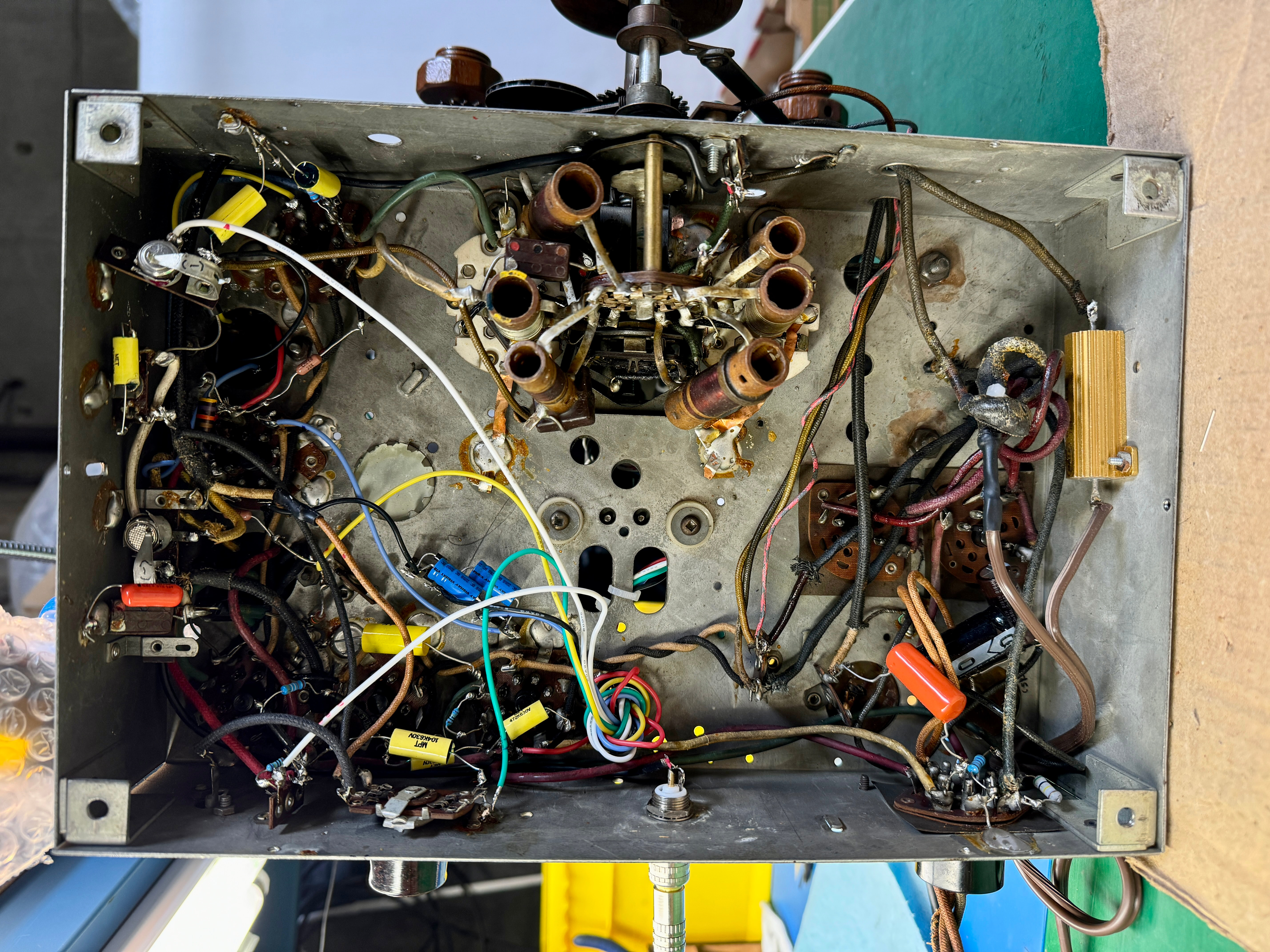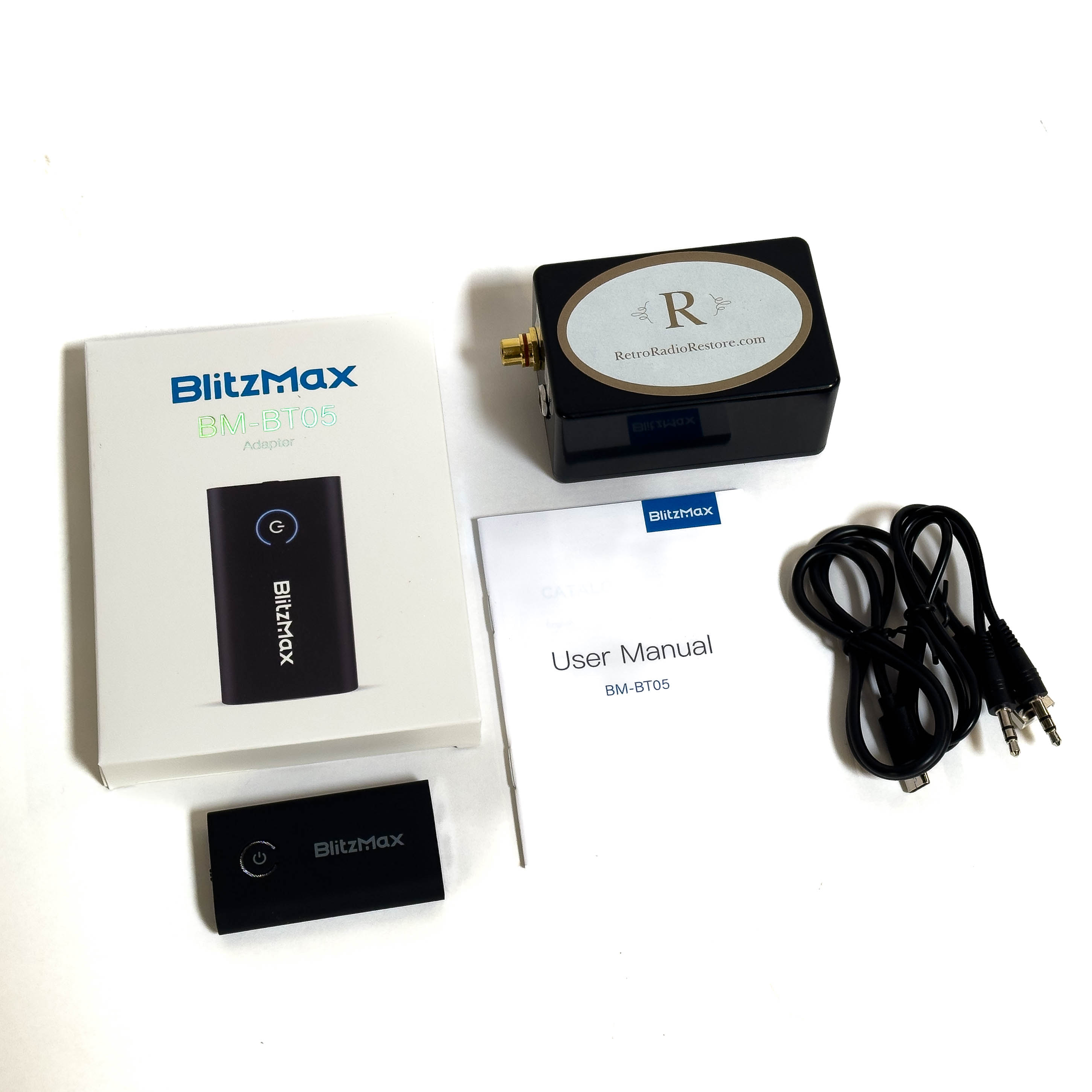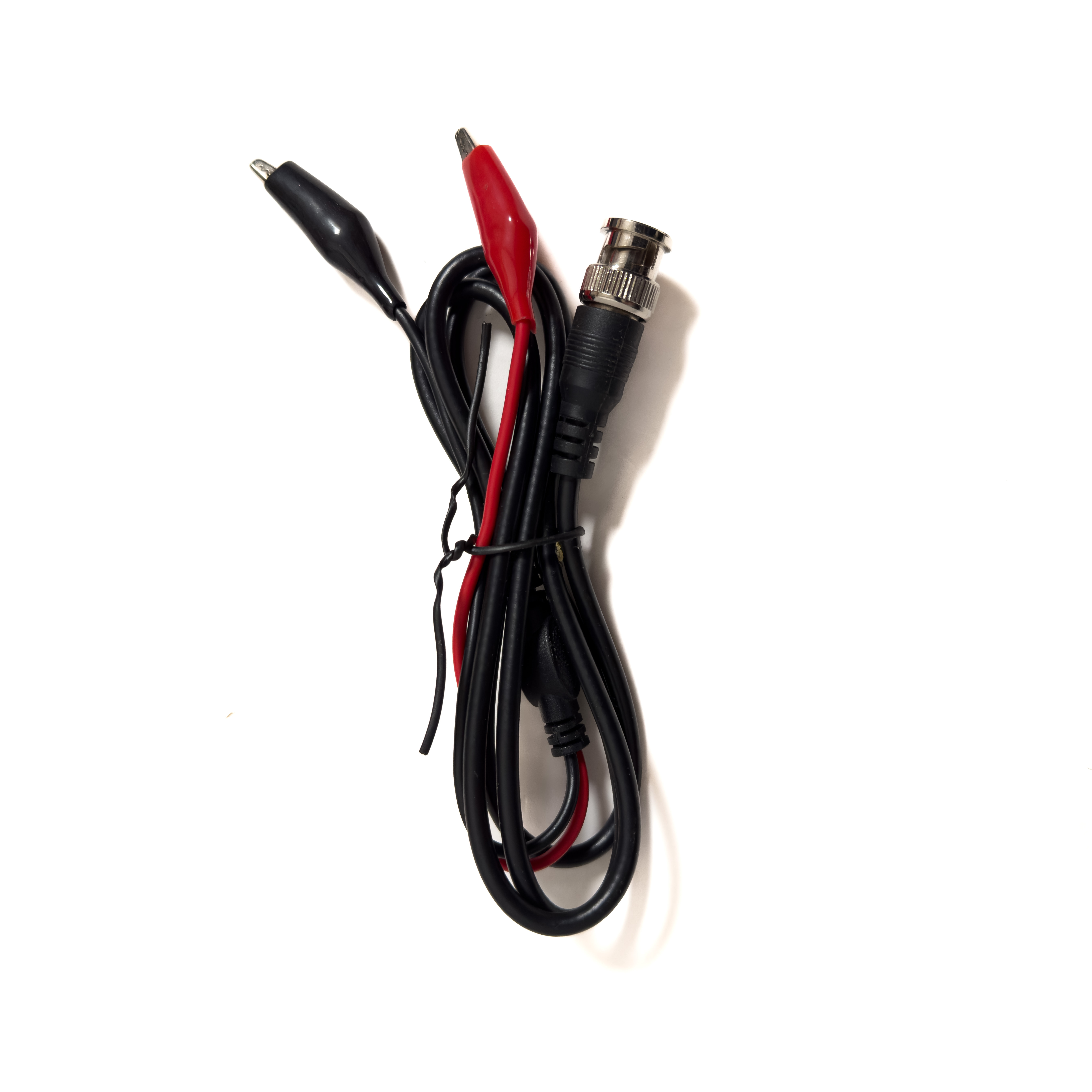- Radios
- >
- DeForest Crosley 7D832 Console (1937)
DeForest Crosley 7D832 Console (1937)
SKU:
$2,900.00
$2,900.00
Unavailable
per item
SOLD
This very rare 1937 DeForest-Crosley console radio is a collector piece. It is an eight-tube, three-band radio sporting a very colorful side-light glass dial and a green magic-eye tuning indicator. The cabinets’ book-matched walnut veneers are perfectly refinished with a clear satin lacquer finish and toned color trim. This chassis got a complete, very time-consuming electronic restoration and has been retrofitted with our exclusive Bluetooth / MP3 input.
History – The DeForest Radio Company was founded in 1907 by Lee de Forest. Its industry was primarily radios, and its headquarters was in New York City. However, at some point they expanded into the Canadian market. The company entered receivership in 1926 and was purchased by Powell Crosley Jr. in 1927. The company name was changed to Consolidated Industries in 1931 and DeForest Crosley remained a brand and a company in the holding. In 1934, Rogers-Majestic acquired the assets of Consolidated Industries Ltd.
The DeForest Prescott was produced in Canada and released in 1937. Production remained through 1938. It shares the same chassis as the Rogers 12-86 and the Majestic 786.
Today, this attractive radio is sought after by collectors but seldom found. We acquired this one in early 2019 from a collector who never restored it. The cabinet was in good shape and had the original finish. The chassis was not working and needed a full restoration and upgrade.
Cabinet – The cabinet got a complete restoration. We stripped the original finish and at great expense replaced the faux paper on the top edges with real walnut burl. We toned the top edge and footer with black lacquer. We treated the veneers with wood conditioner and added grain filler throughout to create a smooth, piano-like finish. The entire cabinet was sealed with a flat satin lacquer. This made the original multi-colored veneers and book-matched walnut veneers pop. We added period correct grille cloth. We retained the original wood control knobs – which were stripped and refinished. The result is this handsome looking radio that will last many, many years into the future.
Dial – The very colorful side-light oval dial displaying all the station frequencies is quite an impressive sight - especially in a dim or dark room. The dial exhibits the broadcast scale and numerous “bands” for reference. Each band’s dial pointer lights up corresponding to the band you select. The letters and numbers are very legible because the faceplate is etched glass.
Overall, the dial mechanism was in poor condition. Wires were crumbling and the turning mechanism was sticky. To fix it we disabled the circular pointer mechanism, cleaned it, created a new more durable wiring harness and installed new bulbs.
Chassis – We took extra steps and worked with the top expert at the California Historical Radio Society to ensure this radio plays well. We went through the entire underside of the chassis replacing all the capacitors, checking, and replacing resistors and wires where needed. It now plays very well across the dial and all bands even with the simplest of antennas.
All tubes were checked and replaced where needed with NOS (new old stock) Rogers tubes. These are very hard to acquire but add to the radio’s authenticity. However, we were not able to locate a 6-volt 6X6 magic tuning eye that was bright enough to use. NOS 6X6 tubes are virtually impossible to find and prohibitively expensive. Instead, we created a voltage driver system to allow the use of a more common 1629 12-volt tuning eye. Once it is warmed up it works and shines clearly.
The main tuning deck was in bad shape. The rubber mounts were completely deteriorated causing the entire deck to wobble. To fix it we removed the entire tuning deck, cleaned and lubricated the main tuning mechanism for smooth tuning operation. We added new silicon rubber mounts and reattached it to the main chassis.
We added a new power cord and voltage dropping resistor for electrical safety to the main chassis. New silicone rubber chassis to cabinet mounts were added for better vibration isolation. Additionally, moved the antenna connections which were in the front of chassis to the rear. For this we installed a BNC connector on the chassis rear to connect a coax antenna. Random wire antenna connection is accommodated with BNC to clip adapter which we provide in the sale (see picture).
This radio already had an auxiliary input and switch on the back, so we created connecting cords for it and aligned the radio for the Bluetooth adapter.
This radio sports a very large round brass manual/automatic tuning selector. We left the original station call letters and assured smooth movement. Station names can be changed by removing the selector and frequencies can be set on the back of the chassis.
Speaker – Even though it performed well, we had the all-original 12-inch speaker cleaned and reinforced. The result is clear audio across the entire audio frequency range. This radio produces exceptional bass tones for its size and the great sound will fill the room.
Bluetooth - Additionally, this radio has been fitted with our custom Bluetooth / MP3 adapter which allows you to switch between the radio or your smartphone or music device. Access your streaming audio service or the playlist on your smart device to provide classic tunes and bring the warm, bright, analogue sound to any music or recording you choose. The quality of the sound is excellent. You will have the best of “digital” and “analogue” combined.
Year of Manufacture: 1937/1938
Band Frequency Ranges:
Standard Broadcast...................520 – 1750 KHz
Amateur/Aviation/ Police…………….1.7 – 6.0 MHz
Short Wave……..……………..…………..….5.5 – 18 MHz
Dimensions: 26”W x 41”H x 15”D
Weight: 40 pounds
See the high-definition demo video here: youtu.be/lYPYE3JIRQo
History – The DeForest Radio Company was founded in 1907 by Lee de Forest. Its industry was primarily radios, and its headquarters was in New York City. However, at some point they expanded into the Canadian market. The company entered receivership in 1926 and was purchased by Powell Crosley Jr. in 1927. The company name was changed to Consolidated Industries in 1931 and DeForest Crosley remained a brand and a company in the holding. In 1934, Rogers-Majestic acquired the assets of Consolidated Industries Ltd.
The DeForest Prescott was produced in Canada and released in 1937. Production remained through 1938. It shares the same chassis as the Rogers 12-86 and the Majestic 786.
Today, this attractive radio is sought after by collectors but seldom found. We acquired this one in early 2019 from a collector who never restored it. The cabinet was in good shape and had the original finish. The chassis was not working and needed a full restoration and upgrade.
Cabinet – The cabinet got a complete restoration. We stripped the original finish and at great expense replaced the faux paper on the top edges with real walnut burl. We toned the top edge and footer with black lacquer. We treated the veneers with wood conditioner and added grain filler throughout to create a smooth, piano-like finish. The entire cabinet was sealed with a flat satin lacquer. This made the original multi-colored veneers and book-matched walnut veneers pop. We added period correct grille cloth. We retained the original wood control knobs – which were stripped and refinished. The result is this handsome looking radio that will last many, many years into the future.
Dial – The very colorful side-light oval dial displaying all the station frequencies is quite an impressive sight - especially in a dim or dark room. The dial exhibits the broadcast scale and numerous “bands” for reference. Each band’s dial pointer lights up corresponding to the band you select. The letters and numbers are very legible because the faceplate is etched glass.
Overall, the dial mechanism was in poor condition. Wires were crumbling and the turning mechanism was sticky. To fix it we disabled the circular pointer mechanism, cleaned it, created a new more durable wiring harness and installed new bulbs.
Chassis – We took extra steps and worked with the top expert at the California Historical Radio Society to ensure this radio plays well. We went through the entire underside of the chassis replacing all the capacitors, checking, and replacing resistors and wires where needed. It now plays very well across the dial and all bands even with the simplest of antennas.
All tubes were checked and replaced where needed with NOS (new old stock) Rogers tubes. These are very hard to acquire but add to the radio’s authenticity. However, we were not able to locate a 6-volt 6X6 magic tuning eye that was bright enough to use. NOS 6X6 tubes are virtually impossible to find and prohibitively expensive. Instead, we created a voltage driver system to allow the use of a more common 1629 12-volt tuning eye. Once it is warmed up it works and shines clearly.
The main tuning deck was in bad shape. The rubber mounts were completely deteriorated causing the entire deck to wobble. To fix it we removed the entire tuning deck, cleaned and lubricated the main tuning mechanism for smooth tuning operation. We added new silicon rubber mounts and reattached it to the main chassis.
We added a new power cord and voltage dropping resistor for electrical safety to the main chassis. New silicone rubber chassis to cabinet mounts were added for better vibration isolation. Additionally, moved the antenna connections which were in the front of chassis to the rear. For this we installed a BNC connector on the chassis rear to connect a coax antenna. Random wire antenna connection is accommodated with BNC to clip adapter which we provide in the sale (see picture).
This radio already had an auxiliary input and switch on the back, so we created connecting cords for it and aligned the radio for the Bluetooth adapter.
This radio sports a very large round brass manual/automatic tuning selector. We left the original station call letters and assured smooth movement. Station names can be changed by removing the selector and frequencies can be set on the back of the chassis.
Speaker – Even though it performed well, we had the all-original 12-inch speaker cleaned and reinforced. The result is clear audio across the entire audio frequency range. This radio produces exceptional bass tones for its size and the great sound will fill the room.
Bluetooth - Additionally, this radio has been fitted with our custom Bluetooth / MP3 adapter which allows you to switch between the radio or your smartphone or music device. Access your streaming audio service or the playlist on your smart device to provide classic tunes and bring the warm, bright, analogue sound to any music or recording you choose. The quality of the sound is excellent. You will have the best of “digital” and “analogue” combined.
Year of Manufacture: 1937/1938
Band Frequency Ranges:
Standard Broadcast...................520 – 1750 KHz
Amateur/Aviation/ Police…………….1.7 – 6.0 MHz
Short Wave……..……………..…………..….5.5 – 18 MHz
Dimensions: 26”W x 41”H x 15”D
Weight: 40 pounds
See the high-definition demo video here: youtu.be/lYPYE3JIRQo
